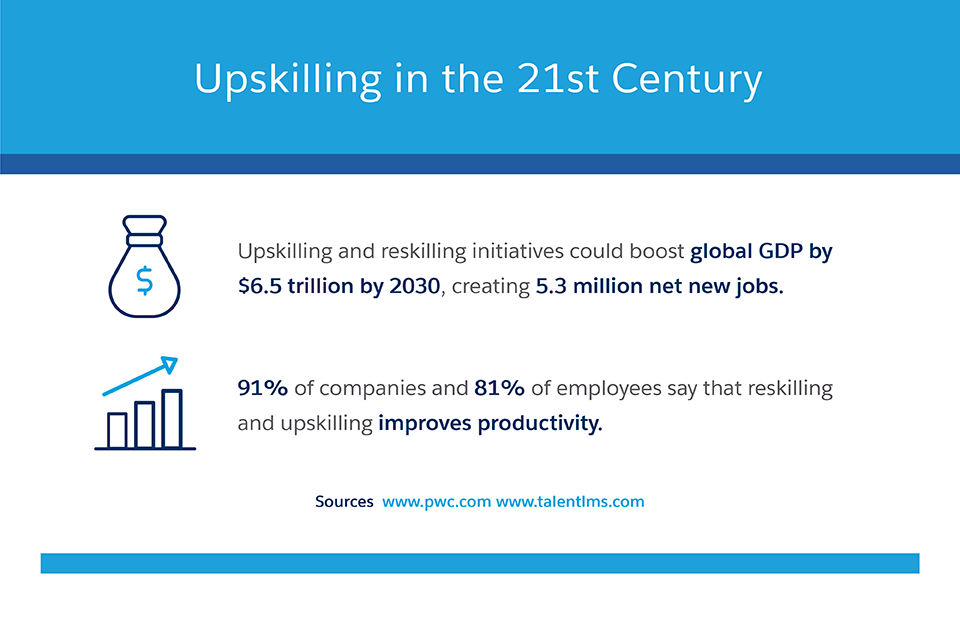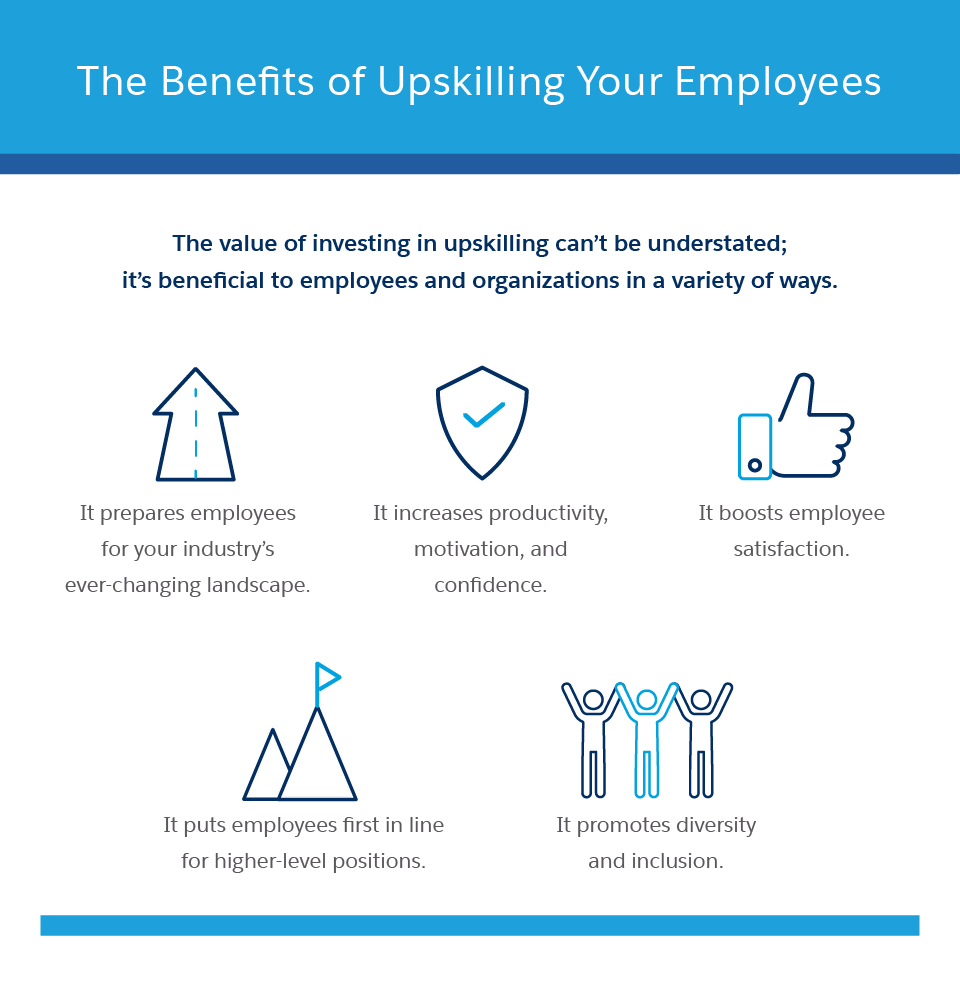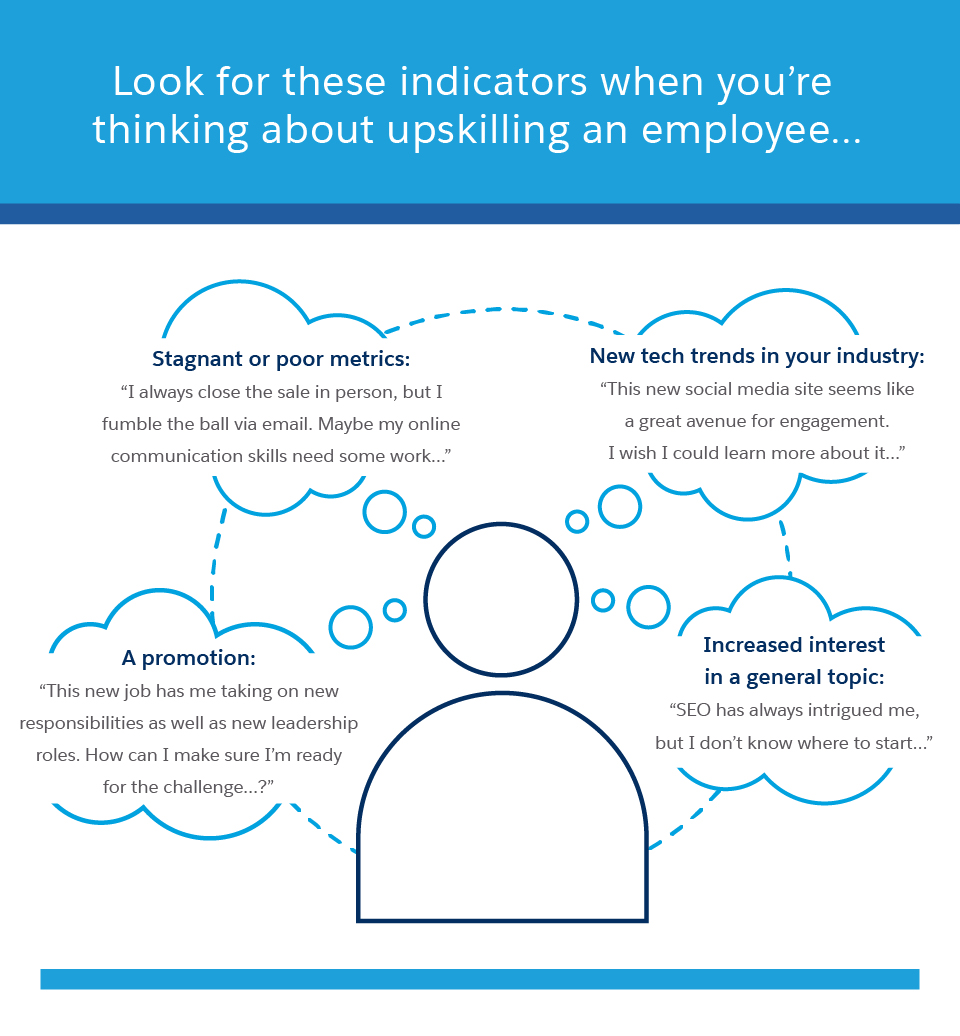Upskilling: What It Is & When It’s Time to Train Your Team



The value of investing in upskilling can’t be understated; it’s beneficial to employees and organizations in a variety of ways.
Kristen Seymour
Upskilling is the technical term for when an employee strengthens existing skills — or learns complementary or advanced skills — that will help them excel at their job.
It’s a great way to address a skills gap within an organization, but it doesn’t necessarily require the worker to learn entirely new skills or prepare for a totally different role. In reality, upskilling forges stronger employees — and may even help prepare them for career growth. While digital upskilling may be the most commonly cited example these days, it’s possible to upskill in a variety of areas, like analytics and organizational transformation skills.
While upskilling shares some similarities with reskilling and cross-skilling, there are key differences to note. Reskilling, for instance, involves taking employees with adjacent skills and providing them with a lateral learning experience so they can do a new job. This could put them into an entirely new industry, or simply into a different department, and may be pursued because their original job has become obsolete or because they want a drastic change. Cross-skilling, on the other hand, focuses more on the development of new skills that can be used in different roles to improve productivity and collaboration across functions or departments.

Why Upskilling Is Important
The value of investing in upskilling can’t be understated; it’s beneficial to employees and organizations in a variety of ways. According to the World Economic Forum, “greater private-public collaboration on large-scale upskilling and reskilling initiatives could boost global GDP by $6.5 trillion and create 5.3 million net new jobs by 2030.”
Here are just a few reasons why upskilling is more crucial now than ever before.
-
Many employees believe they’re currently ill-prepared for a digital-first world. On Salesforce’s Digital Skills Readiness Index, workers worldwide scored 33 out of 100 points in areas including skill level, preparedness, access to learning resources, and upskilling. Workers in Canada scored even lower with 23 points, all of which shows that respondents don’t feel prepared when it comes to the digital skills they need for their work. Upskilling is an efficient way to move that needle.
-
It increases productivity, motivation, and confidence. According to a 2020 TalentLMS report, 91 per cent of companies and 81 per cent of employees say that reskilling and upskilling improves productivity. But it’s not only productivity that sees a benefit — that same report found that two-thirds of employees rank the joy of learning and developing new skills to be a major motivator, and 80 per cent of employees reported that upskilling or reskilling training gave them a confidence boost.
-
Upskilled employees are first in line for higher-level positions. By enabling employees to meet the changing demands of their current jobs, upskilling helps them excel and puts them in a position to be promoted to high demand positions within an organization, which benefits them and is also, of course, of great value to the organization.
-
It boosts employee satisfaction. It’s not news that empowering employees is good for an organization’s bottom line, and since upskilling opportunities lead to personal growth, that also tends to increase both employee engagement and employee retention. In fact, a 2018 Workplace Learning Report by LinkedIn Learning found that 94 per cent of employees would stay at a company longer if that company invested in their career.
It promotes diversity and inclusion. For companies trying to increase diversity, equity, and inclusion efforts at every level, upskilling is essential since it helps to place workers in entry-level roles or specific departments (like customer service, where diversity is generally more prevalent) on a path to career growth within the organization.

Specific Ways to Upskill
Learning and development in the form of online or in-person courses and seminars is probably the most obvious form of upskill training, and there are numerous resources and platforms that offer options in all kinds of areas. Workers can earn certifications for completing some short-term courses or lectures, but even if no certification of completion is offered, strengthening their skills is certainly worth the time, effort, and cost.
However, taking a class isn’t the only way to upskill.
Job rotation, in which employees are temporarily moved between lateral jobs within an organization to facilitate the transfer of skills between departments and workers, is also a useful tactic. This can help prepare a worker for a more senior leadership position, or enable them to work more effectively in their current department because they’ve gotten a better understanding of how other roles within the company function.
Job enlargement and job enrichment are also solid ways to help employees upskill. Job enlargement typically means an employee has new activities added to an existing role, whereas job enrichment offers employees more autonomy as a way to increase motivation — which also leads to strengthened skills.
Don’t forget the impact that employees can have on each other when it comes to upskilling, either. You could consider a peer coaching program, where employees at similar levels (but perhaps different departments) work with one another to share, learn, and grow their skills together.
Bringing in external experts, like freelance specialists, to provide the skills you need for a project can also offer an upskilling opportunity if you team them up with existing workers, allowing your current employees to learn by working with outside sources.
4 Signs It’s Time to Upskill an Employee
It’s clear that upskilling has plenty of benefits — and there are a variety of ways to help employees get the upskill training they’re looking for. But how do you actually determine what they need to learn? Before footing the bill for a course or putting the effort into creating a mentoring program, you first need to know how to identify when an employee is a good candidate for upskilling, and the following suggestions are good places to start.
1. General interest in a topic: Ideally, an employee might express interest in subjects with clear relevance to their work but, if they show interest in something a little outside the box, don’t dismiss that outright. After all, upskilling in areas that help workers better understand their peers or your organization has benefits, too. Offering structured career ladders to your employees is a smart way to help them identify and show interest in areas relevant to their current position or other roles within your organization, helping your HR department meet future demand within the company’s existing workforce. This also creates a culture that showcases a willingness to invest in employees’ futures.
Example: A content marketer might already be an excellent writer who tells compelling stories to connect their brand with its intended audience, but, if they show an interest in learning more about search engine optimization (SEO), upskilling by taking an introductory SEO course could help them to optimize their content, landing those stories in front of more eyes and achieving greater reach.
2. Emerging tech or trends: Digital technology is advancing at an extraordinary rate, and between new social media platforms, new methods of payment, or new digital trends, it’s unreasonable to expect that every employee will automatically keep tabs on every update. It makes sense to provide these employees with a chance (or with an incentive) to learn more about the emerging trends that relate, even remotely, to their work.
Example: There are a number of tech trends that could benefit individuals across industries. Specifically, respondents in the Digital Skills Index named collaboration technology, digital administrative technology, encryption and cybersecurity, e-commerce and digital trade, and project management technology as the most important digital skills for businesses to prepare their employees for.
3. Stagnant or poor metrics: There’s no denying the importance of metrics and analytics, and if you notice a metric that’s not showing the growth you’re expecting, upskilling an employee in the area where you’re seeing that metric trend down could make all the difference.
Example: If a sales rep seems to continually get ghosted by promising leads via email, a writing course that helps the salesperson communicate more effectively could be the key to resolving that issue and achieving sales conversions.
4. A promotion: Often, a job prepares an employee for many aspects of a promotion, but not all. That’s where upskilling can make a huge difference. After all, your promotion-worthy employee may excel at the hard skills required for the new position, but if they’re new to leadership, learning some of the necessary soft skills via a class could help better prepare them for their new role.
Example: Say a team member has been promoted into a project manager position due to their ability to keep multiple aspects of a large project on course. However, if they’re more accustomed to sitting behind a computer than building a team, providing them with real-life training on emotional intelligence, leadership, or teamwork may help them succeed.

Conclusion
Upskilling can be useful for workers at every level, and upskilling opportunities can be found in just about every imaginable topic. From digital technology to interpersonal skills, from copywriting to finance, if you see — or predict — a skills gap in your organization, there’s a course, certification, or other upskill opportunity that can help prepare an employee to fill it. It’s important to invest and cultivate the talent on your team. Your next great employee may be sitting right in front of you.





















